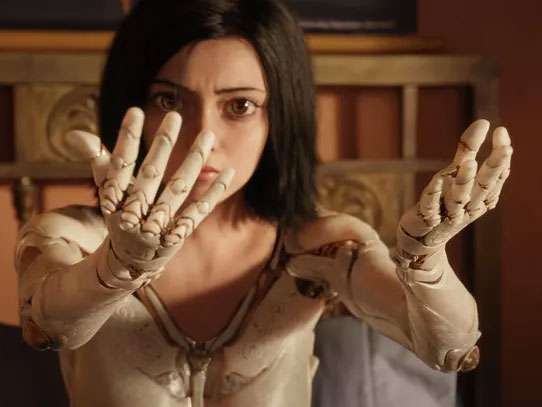Alita: Battle Angel Is A Movie About Our Post-Human Future—and Proof It's Already Here

Alita: Battle Angel works a casual post-humanism into nearly every facet of its world. The film, a mega-budget adaptation of a popular manga series by filmmakers Robert Rodriguez and James Cameron, is set in a far-future post-war society where cyborgs are so common as to be unremarkable: People have robot arms, robot legs, and even, like the title character, full-fledged robot bodies. Sometimes their robotic add-ons look like high-end limb replacements, but often they appear more like industrial machinery grafted on to the human form. It's a movie that raises the question, why drive a lift when you can be one?
There's a low-level market logic to this post-human landscape: The owners of these parts pay for upgrades and maintenance, and, because they are worth something, thieves occasionally try to steal the most valuable parts. When the movie opens, we see one mostly roboticized worker, more dirt-mover than man, paying for some limb repairs with a bag of fresh oranges. Adam Smith long ago noted that humans have a "propensity to truck, barter, and trade." Alita assumes this holds true even when the human in question looks like an actual truck.
The various modifications are employed to facilitate heavy work, to play games, and, rather frequently, to fight (this is, after all, an action movie). At times the movie suggests these people are being exploited by various economic and political forces, but it never seems to pine for a return to a purely organic way of living. It does not embrace a post-human future so much as accept its usefulness and inevitability.
Alas, the movie itself could use some upgrades. Although Alita fills the screen with delightfully zany sci-fi ideas and imagery, the script, by Cameron and Laeta Kalogridis, is composed largely of expository treacle punctuated by dull hero's journey pablum.
The supporting cast speaks mostly in monologues designed to explain bits of backstory to Alita, a cyborg head found in a trash pile and given a new life and body by the kindly Dr. Ido (Christopher Waltz, who mostly seems to wonder what he's doing in this movie). Alita, who wakes up in her new body with no memory of her past, tends to respond by affirming her power and identity—"this is who I am" and so on and so forth. But she's written as such a blank that all we really end up knowing about her, aside from some sci-fi backstory about how she became so powerful, is that she's the sort of person who says "this is who I am" a lot.
The screenplay's expository tendencies are compounded by its habit of on-the-nose naming: The story is set in Iron City, an urban industrial zone dominated by something called the Factory, which is, well, you can probably guess. Iron City exists in the shadow of Zalem, the last of the great "sky cities" (you'll never guess what these are), the rest of which fell to Earth hundreds of years earlier, in an event known as, er, "The Fall." The most popular sport is called Motorball, a mechanized game involving motors and balls, and the city has no law but is patrolled by ruthless mercenaries called Hunter-Killers. The name is self-explanatory, but the script offers potted dialogue to explain it anyway.
The overall effect is that Alita feels less like a movie and more like a lavishly rendered Wikipedia entry—a competent but joyless summary of fictional lore and plot details designed to tell you what the movie is about rather than help you come to understand it. It might have been better as a silent film with accompanying footnotes.
Indeed, the visuals are often breathtaking, particularly when it comes to Alita herself, who is rendered as a doll-like creature with unnaturally large and expressive eyes, as are common in Japanese manga. As played by Rosa Salazar, with a heavy assist from the movie's special effects team, Alita is a marvel of big-budget moviemaking, a largely successful attempt to cross the uncanny valley by situating a character squarely within it. With the help of motion capture, which converts an actor's movements into computer animation, Salazar is a kind of virtual cyborg herself—a human performer upgraded by computer-generated enhancements. She has been modified for her professional advancement and our entertainment, to astounding and occasionally unnerving results. The movie has no soul, but at times it almost convinced me she does.
As a story designed to engage the heart and mind, Alita: Battle Angel is less human than human. Yet as a demonstration of Hollywood's technical prowess, it advances its own sci-fi premise: The post-human future is already here.
Show Comments (22)